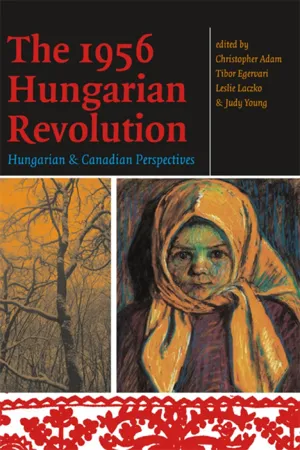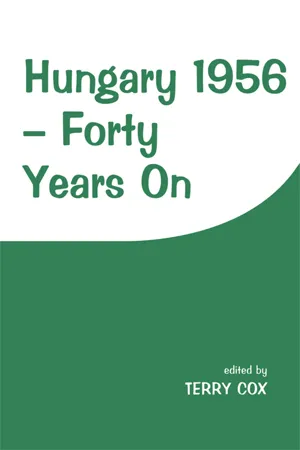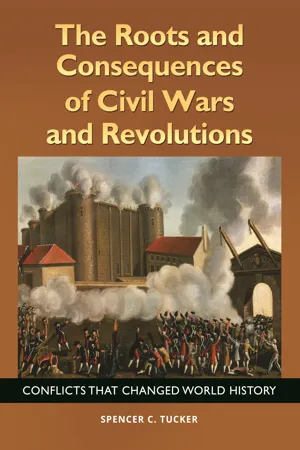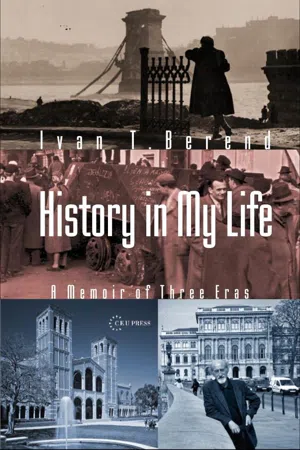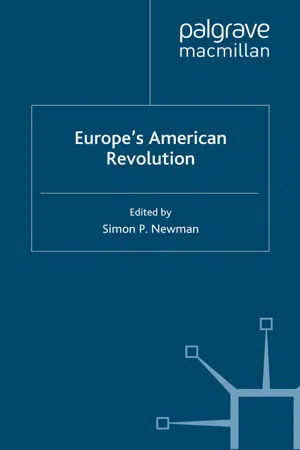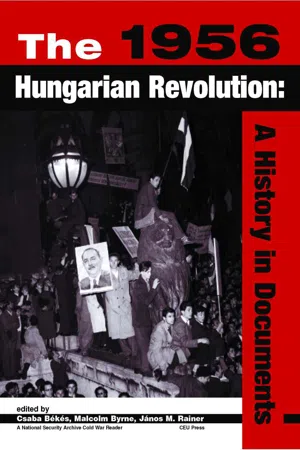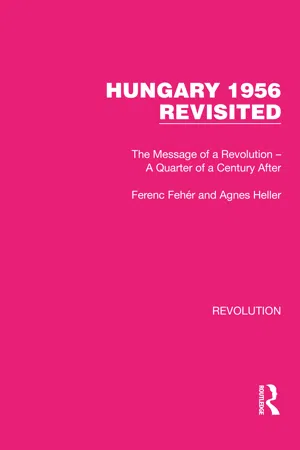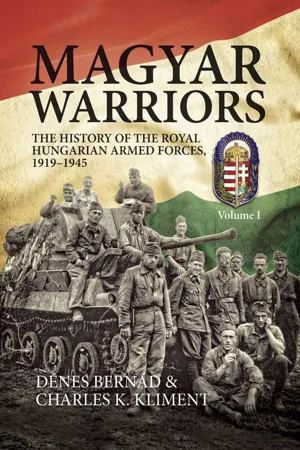History
Hungarian Revolution 1956
The Hungarian Revolution of 1956 was a nationwide uprising against the Soviet-backed Hungarian People's Republic and its policies. It began as a student demonstration and quickly escalated into a full-scale revolt, with demands for political reform and the withdrawal of Soviet forces. The revolution was brutally suppressed by the Soviet Union, resulting in thousands of deaths and mass emigration.
Written by Perlego with AI-assistance
Related key terms
1 of 5
11 Key excerpts on "Hungarian Revolution 1956"
- eBook - ePub
- Árpád von Klimó, Kevin McAleer(Authors)
- 2017(Publication Date)
- Taylor & Francis(Publisher)
1 1956 – key event in Hungarian postwar historyThere are only a very few things about which people are unanimous with regard to the events that took place between 23 October and 4 November 1956. Among these is that those events were of national and world-historical importance. Indeed, what is today officially known in Hungary as “the revolution and struggle for freedom” is the event of recent Hungarian history – an episode that for a short while made the country the focus of the world’s attention. “That capital year in the history of communism,” summarized François Furet, “had two consequences: the bloc began to disintegrate and its unified myth lost its credibility.” The first aspect concerns Soviet-dominated Eastern Europe, and the second the numerous intellectuals and workers in Eastern and Western Europe who were sympathetic toward the Soviet Union, not least because of Stalin’s triumph over Hitler. Both of these factors changed in a fairly abrupt fashion in the autumn of 1956.At first glance, an interpretation of 1956 would seem to be very simple – the white and black hats would seem to be so clearly assigned: A world power of titanic dimensions employs its massive military might to suppress a popular protest movement in a small Central European country, topples a government head that they themselves had placed in power shortly before, and transfers power to an unscrupulous functionary who proceeds to exact bloody revenge against thousands of dissidents. Small wonder that the world was overwhelmingly pulling for the Hungarian freedom fighters, even if Western Europe and the United States never seriously considered fighting alongside these Hungarians in order to decisively change the status quo in Eastern Europe. And another thing is clear: The precise meaning of those events of 1956 is still vehemently debated, in particular ever since 1989. In 2010, Viktor Orbán called 1956 “the unfinished revolution,” the “ongoing struggle” that ended only with the landslide victory of his party. At the occasion of the sixtieth anniversary in 2016, he emphasized that in 1956 Hungarian freedom fighters had “changed the course of history,” which suggests that the dramatic changes of 1989 were less important. However, both dates are closely related. - eBook - ePub
- Christopher Adam, Tibor Egervari, Leslie Laczko, Judy Young(Authors)
- 2010(Publication Date)
- University of Ottawa Press(Publisher)
Part I The Revolution, Hungary, and the WorldPassage contains an image
1.The Hungarian Revolution of 1956: Causes, Aims, and Course of EventsJános M. RainerO n October 23, 1956, a revolution broke out in Budapest and spread all over the country in just a few days. The demonstrators, strikers, armed insurgents, leaders of the organizations of the revolution, and their sympathizers, demanded democratic freedoms and national independence. The first modern anti-totalitarian revolution in Europe lasted for practically two weeks, with another four weeks of rear-guard actions. Its impact could, however, be felt directly or indirectly for decades to come, right up to the change of regimes in 1989–1990.I offer here a survey of the antecedents of 1956 from the point of view of political and social history, as well as the history of ideas. This is followed by a brief history of the revolution and an outline of the strata of active participants. Finally, I attempt to characterize the revolutionaries’ aims.AntecedentsThe need for political, economic, social, and mental change became a constant concern of Hungarian public life from the early 1930s, when the Great Depression began to make an impact in Hungary. The solution to the agrarian question, in the form of land reform, was a perennial topic from the end of World War I onward. The great economic crisis and the outbreak of World War II gave an impetus to reformist thinking, as it became obvious that Hungary would necessarily emerge from the war a different country. The dimensions of the war made it clear that Hungary’s subsequent fate would be greatly determined by the superpower in control of the East-central European region.In 1944 Hungary became part of the Soviet sphere of influence. This fundamentally determined Hungary’s domestic and foreign policy, as well as its social and economic development between 1944 and the late 1980s. All issues that were believed to interfere with Soviet military and political interests and security were decided by the Soviets. Hungarian political life was independent as long as it did not go beyond the limits of this system and remained in harmony with Soviet demands. Whenever a conflict arose, Soviet interests enjoyed absolute priority.1 - eBook - ePub
Hungary 1956
Forty Years On
- Terry Cox(Author)
- 2014(Publication Date)
- Routledge(Publisher)
First, we should note that it has only been in the past few years, following a revision of the official view of 1956 by the ruling communist leadership in 1989, that researchers in Hungary have been able to discuss the events of 1956 openly as a revolution. This has been significant in removing artificial fetters on the scope of their inquiries and enabling them to enter into a dialogue with colleagues elsewhere in a context in which they can share and debate the same terminology and conceptualizations. Second, democratization and greater freedom of information in the 1990s have also enabled researchers to gain access to archives and document collections that were previously closed to them, not only in Hungary but also in the Soviet Union and a number of Western countries. This has led to the publication of a range of articles shedding new light on aspects of the decisions and processes underlying the events of 1956. Third, the political changes since the end of the 1980s have created a more supportive climate in which to carry out oral history and to begin to draw on popular memories of how the revolution was intertwined with everyday life and experiences. Finally, interconnected with this range of new research a wider political debate has taken place on the meaning of the 1956 revolution for present-day Hungary and the extent to which it can provide a basis for the creation of a new tradition to legitimate the newly emerged Hungarian political system. To varying degrees the articles collected in this volume reflect these various developments.The Nature and Origins of the 1956 RevolutionThe historical significance of the events of 1956 in Hungary has been widely recognized ever since they first took place. A major reason for this is that, apart from the very early years of communist rule in the Soviet Union, it was the first occasion in which a communist regime met a major challenge from a widespread mass opposition movement. Although linked in its causes and grievances to other expressions of popular discontent and opposition in the years after the death of Stalin – in East Germany, Czechoslovakia, and most notably Poland – the Hungarian events were distinctive in their nature and consequences. In particular they were exceptional in giving birth to a sustained mass movement that briefly promised a genuine share of state power to non-communist parties and the prospect of a radical restructuring of social relations and institutions throughout Hungarian society.The prospects for such radical restructuring that were opened up by the events of 1956 immediately raised the question of whether they could be seen as a revolution. In the years since then there has been much debate on this question but, in essence, three main objections have emerged to the description of 1956 as a revolution. - eBook - ePub
The Roots and Consequences of Civil Wars and Revolutions
Conflicts That Changed World History
- Spencer C. Tucker(Author)
- 2017(Publication Date)
- ABC-CLIO(Publisher)
Hungarian Revolution (October 23–November 4, 1956) CausesThe Hungarian Revolution of October 23, 1956–November 4, 1956, began in demands for reform but then turned anti-Soviet, only to be crushed by a massive Soviet military intervention. It was one of the major events in the history of the second half of the 20th century and of the Cold War.Following successive waves of conquests and habitation by Celts, Romans, Huns, Slavs, and Gepids, Magyar grand prince Árpád (r. ca. 895–907) conquered much of the Carpathian Basin and consolidated the territory of present-day Hungary, earning the title accorded him by many Hungarians of father of his country. Árpád’s great-grandson Stephen I (r. 1000–1038) made Hungary a Christian kingdom, and by the 12th century Hungary was a significant European power. It reached the height of its influence by the 15th century.Pressure from other more powerful states, notably the Ottoman Empire and Habsburg Austria, ended Hungarian independence. In 1526 the Hungarians suffered a disastrous defeat at the hands of Ottomans in the Battle of Mohács. This led to the partition of Hungary between the Ottoman Empire, the Habsburg Monarchy, and the Principality of Transylvania. Over time the Austrian Habsburgs came to rule all of Hungary. During the widespread European Revolutions of 1848 the Hungarians declared their independence, but the War of Hungarian Independence ended in defeat at the hands of Austrian and Russian troops.Hungarian Revolution (October 23–November 4, 1956)Soviet Military Intervention (November 4, 1956)Troop Strength200,000 ground troops Military Vehicles2,500 tanks and other armored vehicles Total Casualty Estimates, Hungarian RevolutionKilled or WoundedSoviet Troops7,000 Hungarians25,000 Aftermath of the Revolution, Estimated Number of HungariansArrestedTriedConvictedImprisonedExecutedRefugees40,000–50,000 26,000 22,000 13,000 200–500 200,000 Sources: Terry Cox, Hungary 1956—Forty Years on (London: F. Cass, 1997); Paul Lendvai, One Day That Shook the Communist World: The 1956 Hungarian Uprising and Its Legacy - eBook - ePub
Challenging Communism in Eastern Europe
1956 and its Legacy
- Terry Cox(Author)
- 2013(Publication Date)
- Taylor & Francis(Publisher)
Hungarian were examined, the 1956 Revolution would be prominent among them. It is perhaps the best known event in the country’s twentieth-century history, for obvious reasons. First of all, this is the one internationally significant event with a Hungarian dimension that has taken place within living memory. In the West, 1956 took place in the modern media age, so that it was a decisive experience for many important figures in today’s political, cultural and literary life.It was also a positive experience, with appreciable significance, in contrast to the pre-revolutionary image of Hungary and the Hungarians, which had hardly been flattering. Indeed, Hungary’s image had tended to be unfavourable since the turn of the nineteenth and twentieth centuries (Jeszenszky 1986; Evans 2003; Molnár 2001); little occurred between the two world wars to improve it; and Hungary’s wartime alliance with Hitler had done it further damage. Although the Soviet occupation had made the country a victim, that did not alter the image of the Hungarians very much (any more than the praiseworthy efforts of the Hungarian democratic émigré community did).What did result in a change to that image was the 1956 Hungarian Revolution. However, the picture was still one-sided: it now became quite positive but remained one of Hungary as perceived in 1956. The strongest signal that the subjugated societies of Eastern Europe were straining against the Soviet-type system had come from Budapest, but the kind of nationalism to breach the peace of the region did not emerge in 1956. (This had been a persistent, often unjust and exaggerated charge against the Hungarians in earlier decades.) Although the revolution failed, it brought clear victories later on: in the shape of a reformed, more human and liveable type of socialism. The detrimental side of the defeat, on the other hand, was soon forgotten, or remained concealed. The reprisals aroused widespread international outrage but this did not last long and was seldom mentioned after the amnesty of 1963. ‘Fifty-six’ made Hungary ‘different’ in the eyes of the West, distinguishing it from the seeming uniformity of ‘Eastern Europe’. Indeed, Hungary was different, but not as different as Poland, which revolted every 12 years. The 1956 Revolution was scored as a factor in favour of Hungarian society, even though there remained a nimbus around its post-1956 leader, János Kádár, who had defeated the revolution.4 - eBook - PDF
History in My Life
A Memoir of Three Eras
- Ivan T. Berend(Author)
- 2009(Publication Date)
- Central European University Press(Publisher)
John P.C. Matthews, who joined Radio Free Europe in 1951 and later became the head of its European operation, published a monumental book, Explosion. The Hungarian Revolution in 1956 . The nearly 700 page long vol- 72 History in My Life ume discussed the role of my report in a chapter on “Reemergence.” Let me quote a few sentences from his evaluation and his long quotations from the report: The historical subcommittee under Ivan Berend comes up with a ninety-page report…it tells the truth about Imre Nagy’s decision to declare neutrality and withdraw from the Warsaw Pact… The report tells the truth about Kádár, as well… “After November 4, Hungary still had to align its policy with the Soviet political line… from the 1960s up to the middle of the 1980s a practically post-Stalinist policy gained the upper hand, so there was no chance for any radical transformation… The uprising that was called a revolution… soon came to be called… the unfortunate October events, but later… a counter-revolution…” Most important, the report tells the truth about the Revolution itself. “The extremely powerful mass demonstration of October 23 took the place as a response to apparently ineffective old solutions… to be followed the same evening by the ‘critique of arms’ replacing the ‘arms of critique,’ which eventually led to an overall national uprising against the ruling regime. The university students… were soon joined by huge masses of workers in the last week of October. This was demonstrated by their participation in the fight as well as the organization of a united and long-lasting political strike…” At some point Pozsgay decides to reveal to the Hungarian people the major finding in the Berend report: what has been referred to for thirty-two years as a counterrevolution has been found by experts to have been a true national uprising and revolution all along. - eBook - PDF
- S. Newman(Author)
- 2006(Publication Date)
- Palgrave Macmillan(Publisher)
Even though France and Britain overruled Wilson in their reshaping of the Treaty of Versailles, the Hungarians nonetheless held the American president responsible and grew disillusioned with the ideas he had articulated. The American Revolution, and all that it represented, became almost completely irrelevant in inter-war Hungary. 54 The two countries played different roles again in the Second World War. Poland was eliminated by the Soviet Union and Nazi Germany in 1939, but Hungary was able to regain some of its territories through the 114 Csaba Lévai help of the Axis powers. Consequently, Hungary lost the war as an ally of Germany while Poland finished it as a victorious country. Hungary was the enemy and Poland the ally of the United States. But in the end this mattered little, since both nations fell under the influence of the Soviet Union, and by the end of the 1940s the communist parties ruled both Hungary and Poland. 55 The rise and fall of the communist regimes During the Cold War the American republic became the leading power of the so-called free world, and as a result, gradually re-emerged as a positive example and symbol of those ideals that were inaccessible to Hungarians. Due to the oppressed position of the people, and the seri- ous lack of information, Hungarians started to develop a fundamentally positive but highly idealized picture of the United States, despite communist propaganda that suggested, for example, Coca Cola was a dangerous drug employed by bourgeois imperialists to keep American youth under control. The American Revolution did not play a significant role during the anti-communist insurrection of 1956, and the rebels considered the Hungarian Revolution of 1848–49 as their prime inspiration. The United States did not help the Hungarian freedom fighters, and the defeat of the revolt caused some disappointment with the failure of the world’s most powerful nation to help Hungarians achieve freedom and self-determination. - eBook - PDF
Before the Uprising
Hungary under Communism, 1949–1956
- Peter Kenez(Author)
- 2022(Publication Date)
- Cambridge University Press(Publisher)
Serov, in the near future, 36 Uj Tavaszi seregszemle, October 23, 1956, p. 1 (unsigned article). 37 György Litván (ed.), The Hungarian Revolution of 1956. New York: Longman, 1996, no. 1. 38 Hegedüs, pp. 281–283. 39 “Tervszerü vérgengzés a Kossuth téren,” Magyar Hirlap (2012), July 2, 1956. p. 8. After the defeat of the revolution Serov arrested Kopácsi in person. Revolution in the Air 243 would be responsible for carrying out the order of the Soviet Politburo and suppressing the revolution. Soviet troops had stayed in Hungary, after the neutrality of Austria, on the basis of the Warsaw Pact. The Red Army, therefore, never left Hungary after World War II. At dawn on October 23, 1956, before the beginning of the demonstrations in Budapest, extra Soviet troops entered Hungary. 40 The irresolution of the government further demonstrated that it had lost control of the situation. The Demonstration On the morning of October 23, Szabad Nép on its first page reported on the meetings at universities and schools; the author, presumably speaking for the editorial board, expressed his approval for the aspir- ations of the youth. However, in a different article in the same issue a writer express concern that the movement of the youth might be used by hostile forces for agitating against the socialist order. October 23 was a Tuesday, an ordinary weekday. Workers went about their jobs and students were expected to attend classes. However, many students did not go to classes, but were preparing a demonstration that was expected to take place in the afternoon. The routes that the demonstrators were to follow were highly symbolic. The students of universities on the Pest side of the Danube were to meet at the statue of Peto ˝ fi, the poet-hero of 1848. - eBook - PDF
The 1956 Hungarian Revolution
A History in Documents
- Csaba Békés, Malcolm Byrne, János M. Rainer, Csaba Békés, Malcolm Byrne, János M. Rainer(Authors)
- 2002(Publication Date)
- Central European University Press(Publisher)
1 PART ONE HUNGARY BEFORE THE REVOLUTION INTRODUCTION By summer 1952, Hungarian communism had reached a state of crisis. Since the introduc-tion of Stalinist rule just three years earlier, societal pressures had been building steadily under the combined weight of imposed economic rigidity and political excesses in the form of purges, show trials, and other extreme methods of control. The first cases of mass resistance against the system came in the critical agricultural sphere where peasants refused to go along with compul-sory agricultural quotas and grain threshers went on strike leading to outbreaks of violence between farmers and local authorities. Hungarian communist party leader Mátyás Rákosi’s instinct for dealing with the crisis was, as always, to imitate his benefactor, Soviet dictator Joseph Stalin. Just as Stalin was then in the midst of his final campaign of political vengeance at home, Rákosi decided to turn the system’s repressive apparatus against his own colleagues in the leadership. At the beginning of January 1953, he ordered the arrest of Gábor Péter, head of the State Security Authority (ÁVH), and sev-eral other ÁVH officers, as well as a number of leading party functionaries. He sacked two other members of the top-level Hungarian Workers’ Party (HWP) Political Committee, István Kovács and Zoltán Vas, and exiled them to the provinces. Their Jewish background suggested the influ-ence of Stalin’s own “anti-Zionist” purges. Far from being resolved, then, the crisis that had been bubbling up from below for months was now beginning to take its toll on the leadership. This was the state of affairs when news of Stalin’s death arrived on March 5, 1953. Soviet Policy after Stalin After the dictator’s passing, the new Soviet leadership tried to make significant changes in both the domestic life and foreign policy of the empire. - eBook - ePub
Hungary 1956 Revisited
The Message of a Revolution – A Quarter of a Century After
- Ferenc Fehér, Agnes Heller(Authors)
- 2022(Publication Date)
- Routledge(Publisher)
reorganised) party declaring 23 October the day of a glorious uprising restoring Hungarian freedom and national independence. Kádár, one of the most suspicious minds ever involved in Hungarian political life, who, as a prisoner for many years, had learned the Russian lesson the hard way, was hardly the man to be lured into such a gravely incriminating statement without both prior consultations with Andropov and the belief that there was at least a chance of the ‘Finlandisation’ of Hungary (in which case, of course, he did not want to find himself totally out of power as a hardliner Stalinist). To our mind, all of this confirms that the Hungarian revolution did have a chance of lasting success, provided that three factors were simultaneously present: a collective-national Hungarian readiness for a measure of compromise (particularly in matters regarding Soviet strategic interests, and readiness in this respect has been amply proved by us); a convincing signal on the part of the Western, and in particular of the American, governments that détente would be initiated forthwith (and its absence has equally amply been proved by us); plus the combined pressure on the part of Chinese, Yugoslav, Italian and French communists on the Soviet government to come to terms with the Hungarian defeat. We know where we stand as far as the third prerequisite is concerned. Bibó makes the following short statement on the cause of the events becoming revolutionary: But, anyhow, the fact that the Hungarian revolution gained momentum was not a result of its own insensibility but of the foolhardiness and bloodshed provoked by the leadership and the secret police forces; and the revolution, despite its being unprepared and unorganised, when seen as a response to bloodshed, was remarkably sober, humane and moderate. 14 Though this much is undoubtedly correct, a full understanding requires a much longer and more complex explanation - eBook - PDF
Magyar Warriors
The History of the Royal Hungarian Armed Forces 1919–1945
- Dénes Bernád, Charles K. Kliment(Authors)
- 2022(Publication Date)
- Helion & Company(Publisher)
This would last almost 137 years, up until 1848. 6 A well-known patriotic tune of the eighteenth to nineteenth centuries is known as the ‘Rákóczi March’. Hector Berlioz orchestrated the piece, and it was also used by Franz Liszt as the basis of his famous Hungarian Rhapsody No. 15. The ‘Rákóczi March’ remains a popular piece in current Hungarian state and military celebrations. A faded and tattered combat flag of the Hungarian Revolution and War of Independence from the Austrian Empire of 1848–1849, carefully preserved in Kézdivásárhely, in the heart of the Székelyföld (Seklerland), eastern Transylvania. Almost 100 years later, it was unfurled to welcome the Hungarian troops marching in, once again, in this traditional Székely (Sekler) region, in September 1940. ‘Éljen a haza!’ – a popular slogan of the Revolution – means ‘Long Live the Homeland!’ A BRIEF HISTORY OF HUNGARY UP TO THE END OF THE SECOND WORLD WAR 23 The most important pro-independence war erupted on 15 March 1848, when the Twelve Point Proclamation was read out by Hungary’s most celebrated poet and revolutionary, Sándor Petőfi. It was inspired by the French Revolution of February 1848, which was followed by a strong liberation movement across most of Europe, in a series of political and military upheavals often called the ‘Spring of the Nations’. The ‘truncated Hungarian Parliament’ had control over less than half of Hungary’s actual territory. Pest-Buda (today Budapest) declared independence from Vienna under the command of Lajos (Louis) Kossuth. It called for the dethronement of the Habsburg Dynasty in Hungary and moved to reunite Transylvania with the homeland. However, the Austrians disapproved of their eastern neighbour’s independence movement and sent the army to crush the revolution. During a year-long series of bloody battles, the Austrian forces were largely defeated.
Index pages curate the most relevant extracts from our library of academic textbooks. They’ve been created using an in-house natural language model (NLM), each adding context and meaning to key research topics.

